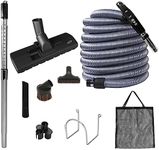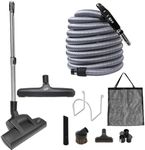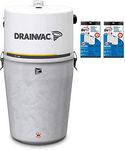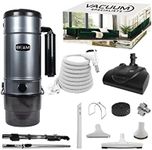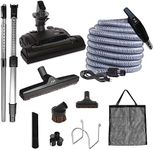Buying Guide for the Best Central Vacuums
Choosing a central vacuum system for your home is a great way to make cleaning more efficient and less of a hassle. Central vacuums are installed into your house and use a network of pipes to carry dirt and debris to a collection unit, usually located in a garage or basement. When picking the right central vacuum, it's important to think about the size of your home, the types of surfaces you’ll be cleaning, and how often you plan to use the system. Understanding the key specifications will help you find a model that fits your needs and makes cleaning easier and more effective.Suction Power (Air Watts)Suction power, often measured in air watts, tells you how strong the vacuum is at picking up dirt and debris. This is important because higher suction power means better cleaning performance, especially on carpets and for picking up heavier particles. Suction power can range from lower values suitable for small apartments or homes with mostly hard floors, to higher values needed for larger homes or those with thick carpets. If you have a big house or lots of carpeted areas, look for a system with higher air watts. For smaller spaces or mostly hard floors, a moderate level will usually be enough.
Coverage Area (Square Footage)Coverage area refers to the maximum size of home the central vacuum can effectively clean, usually measured in square feet. This is important because a system that’s too small for your home won’t clean efficiently, while one that’s too large may be unnecessarily powerful. Coverage area is typically divided into small (up to 2,000 sq ft), medium (2,000–4,000 sq ft), and large (over 4,000 sq ft) homes. To pick the right one, match the system’s coverage rating to the size of your home, including all floors and finished basements.
Filtration TypeFiltration type describes how the vacuum traps dust and allergens before releasing air back into your home. This is important for maintaining good air quality, especially if anyone in your household has allergies. Common types include bagged, bagless, and HEPA filtration. Bagged systems are easy to maintain and good for allergy sufferers, while bagless systems save on replacement bags but may require more frequent cleaning. HEPA filters are best for trapping tiny particles and are ideal if you want the cleanest air possible. Choose the filtration type based on your sensitivity to dust and how much maintenance you’re willing to do.
Noise LevelNoise level tells you how loud the central vacuum will be when in use, usually measured in decibels (dB). This is important if you want a quieter cleaning experience, especially if you have young children, pets, or work from home. Lower decibel ratings mean quieter operation. Central vacuums are generally quieter than portable vacuums, but some are designed to be extra quiet. If noise is a concern, look for models with lower dB ratings or those marketed as quiet or silent.
Installation and Inlet OptionsInstallation and inlet options refer to how the system is set up in your home and how many access points (inlets) you’ll have for connecting the hose. This is important for convenience and ease of use. More inlets mean you won’t have to carry the hose as far, but installation can be more complex. Some systems offer special features like retractable hoses or automatic dustpans. Think about your home’s layout and how you want to use the vacuum—more inlets are better for larger or multi-story homes, while fewer inlets may be fine for smaller spaces.
Canister CapacityCanister capacity is the size of the dirt collection bin or bag. This is important because a larger capacity means you’ll need to empty it less often, which is convenient for bigger homes or frequent cleaning. Canister sizes can range from small (less than 4 gallons) to large (over 8 gallons). If you have a large family or pets, or if you clean often, a bigger canister will save you time and effort. For smaller households or less frequent cleaning, a smaller canister may be sufficient.






